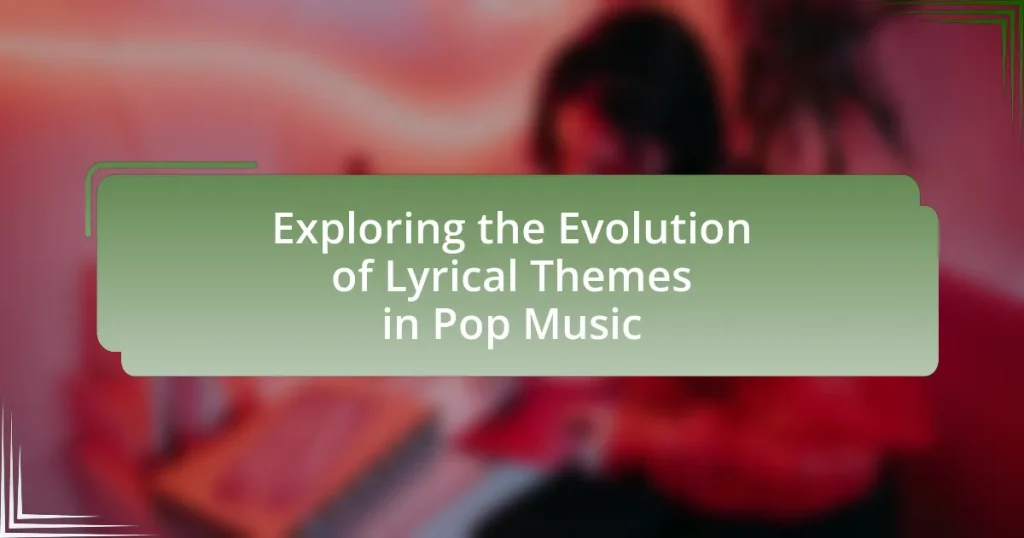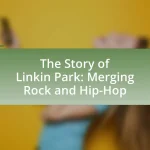The article explores the evolution of lyrical themes in pop music, highlighting key topics such as love, heartbreak, empowerment, and social issues. It examines how societal changes, historical events, and cultural movements have influenced these themes over the decades, from the romantic focus of early pop to contemporary discussions on mental health and activism. The piece also addresses the impact of technology and diversity on modern lyrics, showcasing how collaborations among artists from various backgrounds enrich the lyrical landscape. Practical tips for artists on crafting meaningful lyrics are provided, emphasizing the importance of personal storytelling and relatable themes.
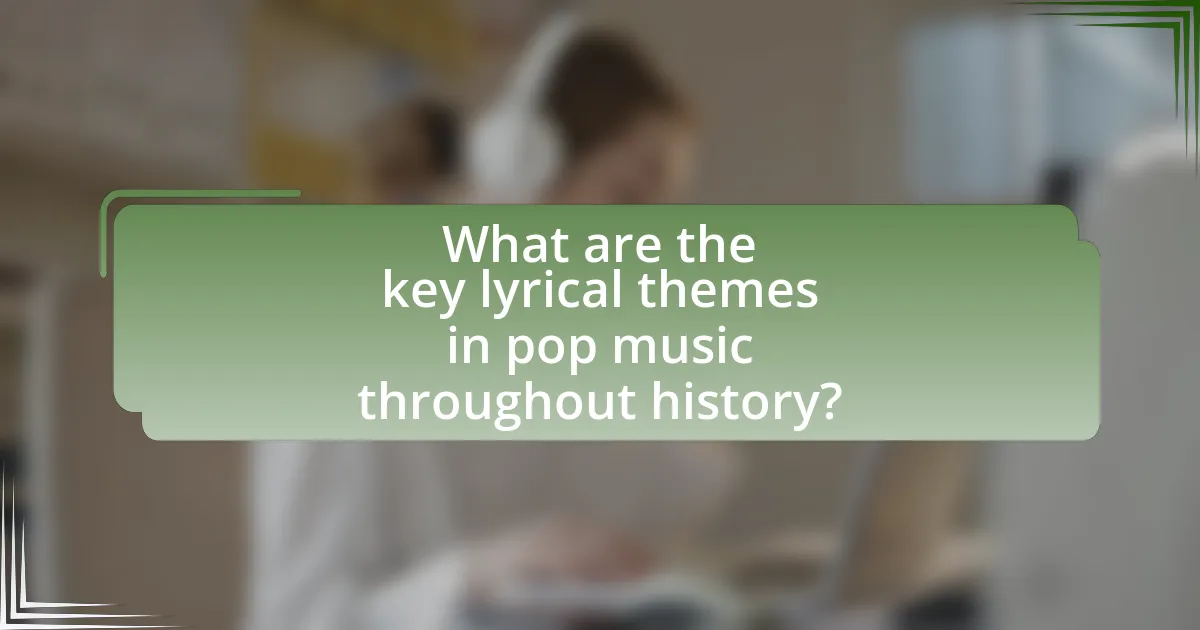
What are the key lyrical themes in pop music throughout history?
Key lyrical themes in pop music throughout history include love, heartbreak, empowerment, and social issues. Love has been a dominant theme since the genre’s inception, with songs like “I Want to Hold Your Hand” by The Beatles illustrating its universal appeal. Heartbreak often follows, as seen in tracks like “Someone Like You” by Adele, which resonate with listeners’ emotional experiences. Empowerment emerged prominently in the late 20th century, exemplified by songs like “Survivor” by Destiny’s Child, reflecting societal shifts towards individual strength. Additionally, social issues have gained traction, with artists like Billie Eilish addressing mental health and climate change in their lyrics, showcasing pop music’s role in cultural commentary. These themes have evolved but remain central to the genre’s identity.
How have societal changes influenced lyrical themes in pop music?
Societal changes have significantly influenced lyrical themes in pop music by reflecting contemporary issues, emotions, and cultural shifts. For instance, the rise of social movements such as feminism and LGBTQ+ rights has led to an increase in songs addressing empowerment, identity, and equality, as seen in tracks like “Born This Way” by Lady Gaga. Additionally, events like the COVID-19 pandemic have prompted artists to explore themes of isolation and resilience, evident in songs like “Stay” by The Kid LAROI and Justin Bieber. Historical contexts, such as the civil rights movement, have also shaped lyrical content, with artists like Marvin Gaye addressing social justice in “What’s Going On.” These examples illustrate how pop music serves as a mirror to societal changes, adapting its themes to resonate with the current cultural landscape.
What historical events have shaped the evolution of pop music lyrics?
The evolution of pop music lyrics has been significantly shaped by historical events such as the civil rights movement, the Vietnam War, and the rise of the internet. The civil rights movement of the 1960s influenced artists like Bob Dylan and Marvin Gaye, who incorporated themes of social justice and equality into their lyrics, reflecting the struggles and aspirations of the time. The Vietnam War prompted a wave of protest songs, with lyrics that expressed dissent and the horrors of war, as seen in tracks like “Fortunate Son” by Creedence Clearwater Revival. Additionally, the advent of the internet in the late 1990s and early 2000s transformed how music was distributed and consumed, leading to a diversification of lyrical themes as artists began to explore personal narratives and global issues, resulting in a more interconnected lyrical landscape. These events collectively illustrate how societal changes and cultural movements have directly influenced the content and themes present in pop music lyrics.
How do cultural movements reflect in the lyrics of pop songs?
Cultural movements significantly influence the lyrics of pop songs by embedding social, political, and emotional themes that resonate with contemporary audiences. For instance, the civil rights movement of the 1960s inspired artists like Sam Cooke, whose song “A Change Is Gonna Come” articulated the struggles for equality and justice. Similarly, the LGBTQ+ rights movement has shaped lyrics in songs like Lady Gaga’s “Born This Way,” which promotes acceptance and self-identity. These examples illustrate how pop music serves as a reflection of societal values and issues, making it a powerful medium for cultural expression and change.
What are the common lyrical themes found in early pop music?
Common lyrical themes found in early pop music include love, heartbreak, and youthful experiences. These themes often reflect the societal norms and emotional landscapes of the time, with love songs dominating the charts. For instance, the 1950s and 1960s saw a surge in romantic ballads, exemplified by artists like Elvis Presley and The Beatles, whose lyrics frequently explored the joys and pains of love. Additionally, themes of nostalgia and innocence were prevalent, as seen in songs like “Teenage Dream” by Katy Perry, which evoke a sense of youthful exuberance. The focus on personal relationships and emotional expression in early pop music laid the groundwork for the genre’s evolution, influencing subsequent generations of artists.
How did love and relationships dominate early pop lyrics?
Love and relationships dominated early pop lyrics primarily due to their universal appeal and emotional resonance. Early pop music, emerging in the 1950s and 1960s, often centered around themes of romance, heartbreak, and desire, reflecting the societal focus on youth culture and personal connections. For instance, artists like Elvis Presley and The Beatles frequently explored love in their songs, which contributed to their widespread popularity and cultural impact. The prevalence of love-themed lyrics can be evidenced by the Billboard Hot 100 charts, where love songs consistently ranked among the top hits, indicating that audiences were drawn to these relatable themes.
What role did escapism play in the lyrical content of early pop music?
Escapism played a significant role in the lyrical content of early pop music by providing listeners an emotional refuge from everyday life. Early pop songs often featured themes of love, adventure, and fantasy, allowing audiences to momentarily escape their realities. For instance, songs like “Chantilly Lace” by The Big Bopper and “Love and Marriage” by Frank Sinatra encapsulated idealized scenarios that contrasted with the struggles of post-war society. This focus on uplifting and imaginative narratives helped to establish pop music as a source of comfort and joy, reinforcing its popularity during the 1950s and 1960s.
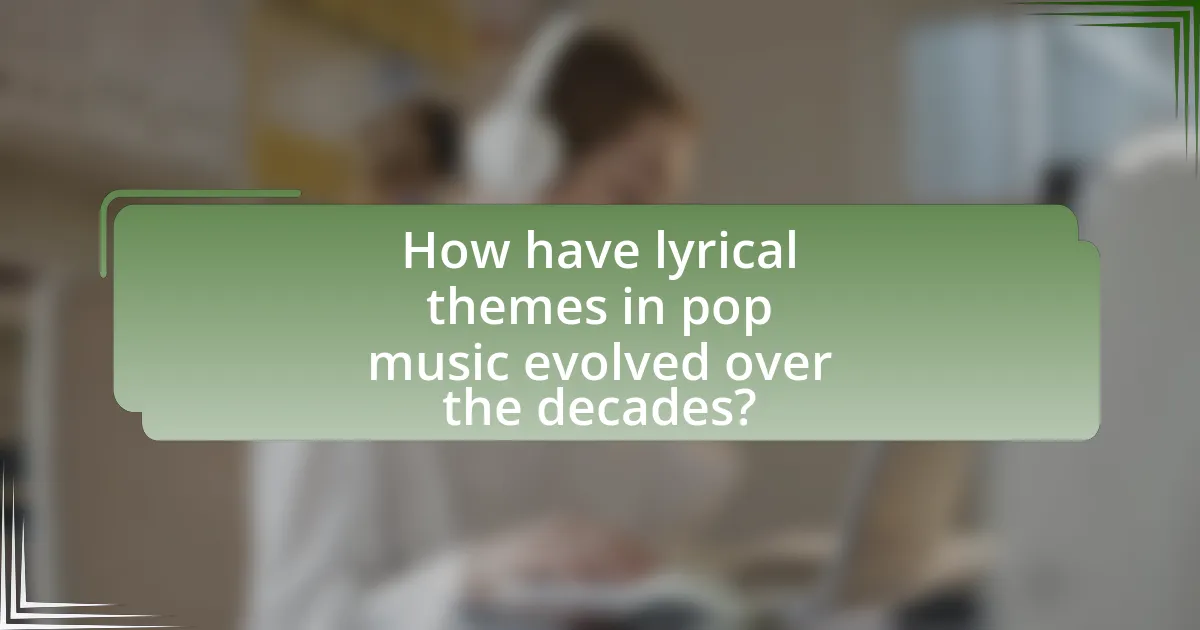
How have lyrical themes in pop music evolved over the decades?
Lyrical themes in pop music have evolved significantly over the decades, reflecting societal changes and cultural shifts. In the 1950s and 1960s, themes often centered around love and romance, as seen in the works of artists like Elvis Presley and The Beatles. The 1970s introduced more diverse themes, including social issues and personal freedom, exemplified by songs from artists like Marvin Gaye and Fleetwood Mac.
The 1980s and 1990s saw a rise in themes of empowerment and rebellion, with artists like Madonna and Nirvana addressing gender roles and youth disillusionment. In the 2000s, pop music began to incorporate themes of technology and digital culture, as reflected in the works of artists like Britney Spears and Lady Gaga.
Most recently, the 2010s and 2020s have seen a focus on mental health, identity, and social justice, with artists like Billie Eilish and Lizzo leading the charge. This evolution illustrates how pop music not only mirrors but also influences the cultural landscape, adapting to the values and concerns of each generation.
What shifts occurred in lyrical themes during the 1960s and 1970s?
During the 1960s and 1970s, lyrical themes in pop music shifted significantly from romantic and simplistic narratives to more complex and socially conscious topics. This change was influenced by cultural movements such as civil rights, anti-war protests, and the counterculture revolution, which prompted artists to address issues like political unrest, personal identity, and social justice. For example, songs like Bob Dylan’s “The Times They Are a-Changin'” and Marvin Gaye’s “What’s Going On” exemplified this shift by tackling themes of social change and emotional depth, reflecting the turbulent societal landscape of the time.
How did the counterculture movement influence pop music lyrics?
The counterculture movement significantly influenced pop music lyrics by introducing themes of social change, anti-establishment sentiments, and personal freedom. Artists like Bob Dylan and The Beatles incorporated messages that challenged societal norms and addressed issues such as civil rights, war, and drug use. For instance, Dylan’s song “The Times They Are a-Changin'” became an anthem for change, reflecting the desire for social justice during the 1960s. This shift in lyrical content marked a departure from earlier pop music, which often focused on romance and escapism, showcasing the counterculture’s impact on the evolution of lyrical themes in pop music.
What themes emerged in pop music during the disco era?
During the disco era, themes of love, liberation, and celebration prominently emerged in pop music. Songs often focused on romantic relationships, expressing joy and desire, as exemplified by tracks like “I Will Survive” by Gloria Gaynor, which conveyed empowerment and resilience. Additionally, the disco genre embraced themes of nightlife and escapism, reflecting the vibrant club culture of the 1970s, as seen in hits like “Stayin’ Alive” by the Bee Gees, which captured the spirit of survival and enjoyment amidst societal challenges. These themes resonated with audiences, contributing to the genre’s widespread popularity and cultural significance.
What are the defining lyrical themes of the 1980s and 1990s pop music?
The defining lyrical themes of 1980s and 1990s pop music include love and relationships, social issues, and self-empowerment. Love and relationships were prevalent, with artists like Whitney Houston and Madonna exploring romantic themes in their hits. Social issues emerged prominently, as seen in songs like Michael Jackson’s “Black or White,” which addressed race and equality. Additionally, self-empowerment became a significant theme, exemplified by tracks like “I Will Survive” by Gloria Gaynor, which resonated with audiences seeking strength and resilience. These themes reflect the cultural and societal shifts of the era, making them integral to the pop music landscape of the time.
How did technology and media impact the lyrical content of this era?
Technology and media significantly transformed the lyrical content of this era by enabling artists to access a broader range of influences and communicate directly with audiences. The rise of digital platforms, such as social media and streaming services, allowed musicians to share their work instantly, leading to a more diverse array of themes and styles in lyrics. For instance, the accessibility of production tools has democratized music creation, resulting in lyrics that reflect personal experiences and social issues more authentically. Additionally, the influence of global media has introduced cross-cultural elements into pop music, as seen in the incorporation of various languages and cultural references in lyrics. This shift is evidenced by the increasing popularity of genres like reggaeton and K-pop, which blend traditional elements with contemporary themes, showcasing the impact of technology and media on lyrical evolution.
What role did personal storytelling play in 1990s pop lyrics?
Personal storytelling was central to 1990s pop lyrics, as it allowed artists to connect with listeners on an emotional level. This era saw a shift from abstract themes to more relatable narratives, with artists like Alanis Morissette and Britney Spears using their personal experiences to craft songs that resonated with a wide audience. For instance, Morissette’s album “Jagged Little Pill” featured raw, autobiographical lyrics that addressed themes of heartbreak and self-discovery, which contributed to its critical and commercial success. This focus on personal storytelling not only defined the sound of the decade but also influenced subsequent generations of musicians, establishing a trend toward authenticity in pop music.
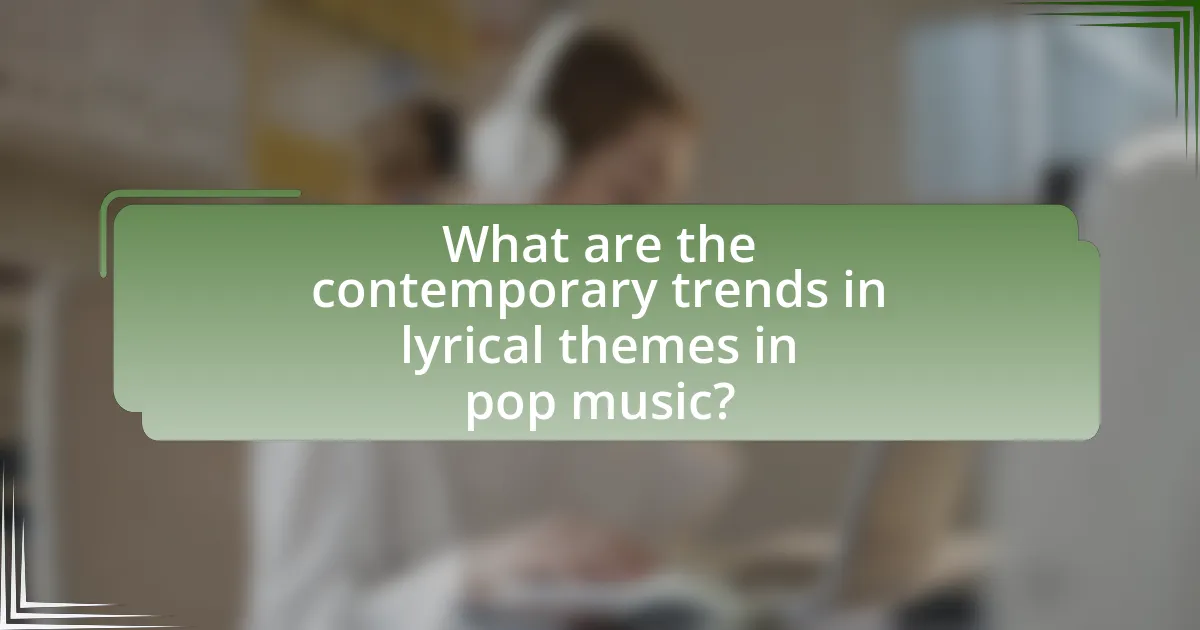
What are the contemporary trends in lyrical themes in pop music?
Contemporary trends in lyrical themes in pop music include a focus on mental health, empowerment, and social issues. Artists increasingly address personal struggles, such as anxiety and depression, reflecting a broader societal conversation about mental well-being. For example, songs like “1-800-273-8255” by Logic directly tackle suicide prevention, illustrating the genre’s commitment to raising awareness. Additionally, themes of empowerment, particularly regarding gender and identity, are prevalent, as seen in tracks like “Truth Hurts” by Lizzo, which promotes self-love and confidence. Social issues, including racial justice and climate change, are also prominent, with artists like Billie Eilish using their platforms to advocate for change, as evidenced in her song “All the Good Girls Go to Hell,” which addresses environmental concerns. These trends indicate a shift towards more meaningful and socially conscious content in pop music.
How do modern pop lyrics address social issues and activism?
Modern pop lyrics increasingly address social issues and activism by incorporating themes of equality, mental health, and environmental concerns. Artists like Billie Eilish and Hozier use their platforms to highlight systemic injustices, such as racial inequality and climate change, through poignant lyrics that resonate with listeners. For instance, Eilish’s song “Your Power” critiques the abuse of power and its impact on vulnerable individuals, reflecting a broader societal concern. Additionally, the rise of movements like Black Lives Matter has influenced pop music, prompting artists to create songs that advocate for social justice and raise awareness about pressing issues. This trend demonstrates how contemporary pop music serves as a vehicle for activism, engaging audiences in critical conversations about societal challenges.
What examples illustrate the integration of political themes in current pop music?
Current pop music integrates political themes through various artists and their impactful songs. For instance, Billie Eilish’s “Your Power” addresses issues of abuse and power dynamics, reflecting societal concerns about consent and exploitation. Similarly, H.E.R.’s “I Can’t Breathe” directly responds to the Black Lives Matter movement, emphasizing racial injustice and police brutality. Additionally, Lil Baby’s “The Bigger Picture” articulates the struggles faced by the Black community, particularly in the context of protests against systemic racism. These examples demonstrate how contemporary pop music serves as a platform for political discourse, resonating with listeners and raising awareness about critical social issues.
How do contemporary artists use their platform to discuss mental health in lyrics?
Contemporary artists use their platform to discuss mental health in lyrics by openly addressing personal struggles and societal issues related to mental well-being. For instance, artists like Logic in his song “1-800-273-8255” directly reference suicide prevention and mental health awareness, leading to increased calls to the National Suicide Prevention Lifeline by 50% after its release. Similarly, Billie Eilish’s lyrics often explore themes of anxiety and depression, resonating with a younger audience and fostering conversations around these topics. This approach not only normalizes discussions about mental health but also encourages listeners to seek help and support.
What role does diversity play in the lyrical themes of today’s pop music?
Diversity plays a crucial role in shaping the lyrical themes of today’s pop music by reflecting a wide range of cultural, social, and personal experiences. This inclusion of diverse perspectives allows artists to address issues such as identity, race, gender, and sexuality, resonating with a broader audience. For instance, songs like “Born This Way” by Lady Gaga and “This Is America” by Childish Gambino tackle themes of LGBTQ+ rights and racial inequality, respectively, showcasing how diversity informs the narrative and emotional depth of contemporary pop music. The increasing representation of various backgrounds in the music industry further amplifies these themes, as artists from different cultures bring unique stories and viewpoints to their lyrics, enriching the overall landscape of pop music.
How are different cultural influences represented in modern pop lyrics?
Different cultural influences are represented in modern pop lyrics through the incorporation of diverse languages, themes, and musical styles. For instance, artists like Bad Bunny and BTS blend Spanish and Korean lyrics with English, reflecting their cultural backgrounds while appealing to global audiences. Additionally, themes such as identity, social justice, and personal experiences often draw from specific cultural narratives, as seen in songs addressing issues like immigration and racial inequality. This blending of cultural elements not only enriches the lyrical content but also resonates with listeners from various backgrounds, showcasing the global nature of contemporary pop music.
What impact does collaboration among diverse artists have on lyrical themes?
Collaboration among diverse artists significantly enriches lyrical themes by introducing varied perspectives and cultural influences. This blending of backgrounds allows for a more nuanced exploration of topics such as identity, love, and social issues, reflecting a broader range of human experiences. For instance, the collaboration between artists from different genres, such as hip-hop and country, often results in lyrics that address themes of resilience and community in unique ways, as seen in the song “Old Town Road” by Lil Nas X featuring Billy Ray Cyrus, which combines elements from both genres to discuss themes of freedom and defiance. Such collaborations not only enhance the depth of lyrical content but also foster cross-cultural dialogue, making the music more relatable to a diverse audience.
What practical tips can artists use to craft meaningful lyrics in pop music?
Artists can craft meaningful lyrics in pop music by focusing on personal experiences, using vivid imagery, and employing relatable themes. Personal experiences provide authenticity, allowing listeners to connect emotionally; for instance, Taylor Swift often draws from her life, making her songs resonate deeply with fans. Vivid imagery enhances the storytelling aspect, as seen in songs like “Firework” by Katy Perry, which uses visual metaphors to convey empowerment. Additionally, relatable themes such as love, heartbreak, and self-discovery are prevalent in successful pop songs, as they reflect universal human emotions, making them accessible to a wide audience.
